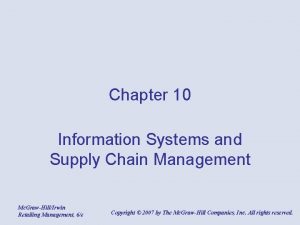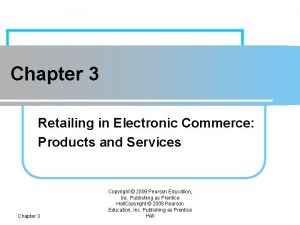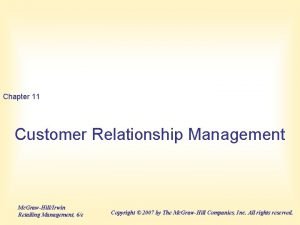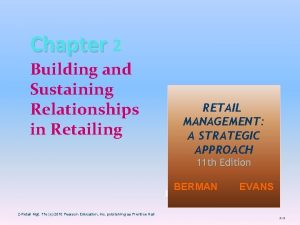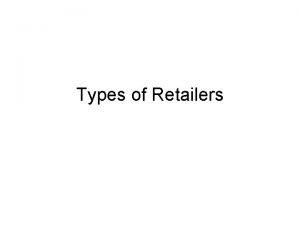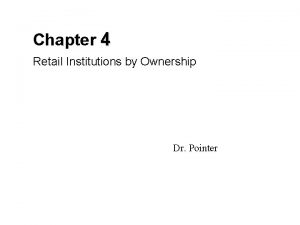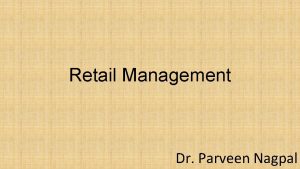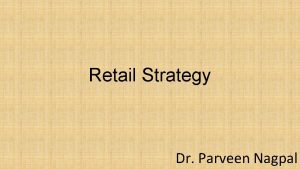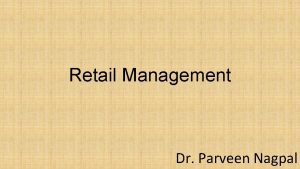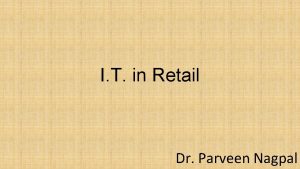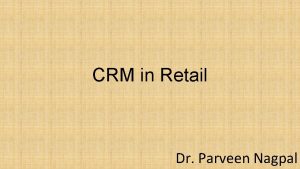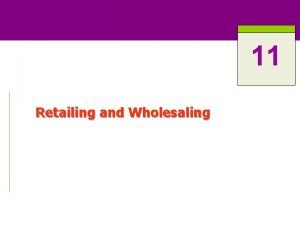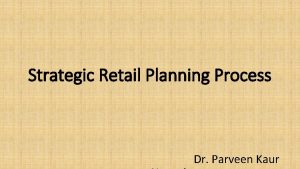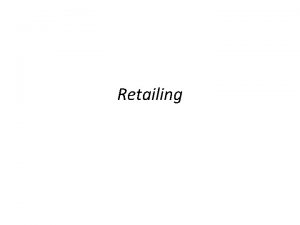Retail Logistics Dr Parveen Nagpal Retail Logistics Retailing


















- Slides: 18

Retail Logistics Dr. Parveen Nagpal

Retail Logistics • Retailing and logistics are concerned with product availability • Logistics is viewed as the competent which links an enterprise with its consumers and suppliers. • Philip Kotler (2001) defines logistics as “planning, implementing and controlling the physical flows of materials and final goods from point of origin to point of use to meet customer’s need at a profit”. • Information from and about customers flows through the enterprise in the form of sales activity, forecast and orders. This information is thus translated into manufacturing and purchasing plans. • As the product and materials are procured, value addition takes place along with the inventory flow that ultimately results in transfer of ownership of finished products to customers.

Retail Logistics • The process of logistics can be viewed in terms of two inter-related efforts, inventory flow and information flow • In order to make products available, retailers have to manage their logistics in terms of product movement and demand management. • Retailers need to know what is selling through their stores and their websites, anticipate and react quickly to changes in demand. At the same time they need to be able to move less demand-volatile (having unpredictable demand) products in an efficient and cost-effective manner. • Logistics is the aspect of supply chain management that refers to the planning, implementation, and control of the efficient flow and storage of goods, services, and related information from the point of origin to the point of consumption to meet customers’ needs.

Retail Logistics The logistics management task is concerned with managing the components of the ‘logistics mix’. The components are: i. Storage Facilities: Retailers manage the warehouse or stock room facilities to enable them to keep stock in anticipation of, or to react to, demand for products. ii. Inventory: All retailers hold stock to some extent. He should understand the amount of stock or inventory (finished products and/or component parts) that has to be held for each product and the location of this stock to meet demand changes. iii. Transportation: Most products have to be transported in some way at some stage from production to consumption. Retailers therefore have to manage a transport operation that might involve different forms of transport, different sizes of containers and vehicles and the scheduling and availability of drivers and vehicles.

Retail Logistics iv. Unitization and Packaging: Consumers generally buy products in small quantities. They sometimes make purchase decisions based on product presentation and packaging. Retailers are concerned to develop products that are easy to handle in logistics terms, do not cost too much to package or handle, yet retain their selling ability on the shelves. v. Communications: In order to get products to where retailers need them, it is necessary to have information, not only about demand supply, but also about volumes, stock, prices and movements. Retailers have thus become increasingly concerned with being able to capture data at appropriate points in the system and to use that information to have a more efficient and effective logistics operation.

Supply Chain Management (SCM) • Supply Chain Management (SCM) involves the management of flow of goods and services and includes all processes that transform the raw material into final products. It involves active streamlining of a business’ supply side activities. • According to the Council of SCM Professionals: “SCM encompasses the planning and controlling of all processes involved in procurement, conversion, transportation and distribution across a supply chain. SCM includes coordination and collaboration between partners, which can be suppliers, intermediaries, third party service providers, and customers. In essence, SCM integrates supply and demand management within and between companies in order to serve the needs of end-customer”. • Enhanced supply chain can increase satisfaction level of customers and hugely improve manufacturing operations.

Strategic Advantage through Efficient SCM • Supply chain management and information systems have become important tools for achieving a sustainable competitive advantage. • Developing more efficient methods of distributing merchandise creates an opportunity to reduce costs and prices and ensure that the right merchandise is available when and where customers want it. • The systems used to control the flow of information to buyers and then on to vendors have become quite sophisticated. • Retailers have developed data warehouses that provide them with intimate knowledge of who their customers are and what they like to buy. • Purchase data collected at the point of sale goes into a database known as a Data Warehouse. • The information stored in the data warehouse is accessible on various dimensions and levels

Strategic Advantage through Efficient SCM • Data can be accessed according to: i. The level of merchandise aggregation – SKU (item), vendor, category (frocks), department (kid’s apparel), or all merchandise. ii. Level of the company – store, division, or total company. iii. Point in time—day, season, or year. • Data warehouses also contains detailed information about customers, which is used to target promotions and group products together in stores. • Data warehouses are being used to strengthen the relationships with their customers and improve the productivity of their marketing and inventory management efforts.

Example: Amazon is a US e-commerce and cloud computing company. Their headquarters are based in Seattle, Washington and they are the largest internet -based retailer in the United States. Amazon was one of the first companies that started selling book online. Currently their range of products doesn’t stop there; they also sell music, videogames, shoes, clothing, luggage and many other accessories. Amazon offers about everything you can think of and their variety in offers and products along with their customer driven shopping and recommendations is a hit with customers. One of the reasons why Amazon can have such a wide spectrum of products is the fact that they are not limited by physical spaces, since they don’t have actual stores. Their supply chain goes from the lowest levels of inventory, through the logistics of the order itself all the way up to an outstanding distribution chain of their products in an international scale. Amazon can currently ship close to 10 million different products. This diversity gives it an edge against competitors and makes it a perfect example of what efficient supply chain management can accomplish. (Source: https: //davidkigerinfo. wordpress. com/2016/03/08/5 -examples-ofsome-of-the-best-supply-chain-management)

Strategic Advantage through Efficient SCM The physical flow of merchandise within the supply chain: 1. Merchandise flows from vendor to distribution center 2. Merchandise goes from distribution center to stores 3. Alternatively, merchandise can go from vendor directly to stores or even the customer. Customer Store Vendor Distribution Centre

Distribution Centre The Distribution Center performs activities such as: 1. Coordinating Inbound Transportation: Inbound logistics refers to the transport, storage and delivery of goods coming into a business. 2. Receiving and Checking: Receiving is the process of recording the receipt of merchandise as it arrives at a distribution center. Checking is the process of going through the goods on receipt to make sure that they arrived undamaged and that the merchandise ordered is received properly. 3. Storing and Cross-docking: Once the merchandise is received and checked, it is either stored or cross-docked. Cross docking is a logistics procedure where products from a supplier or manufacturing plant are distributed directly to a customer or retail chain with very less or no handling or storage time.

Distribution Centre 4. Getting Merchandise “floor-ready”: Floor-ready merchandise is merchandise that is ready to be placed on the selling floor. Getting merchandise floor-ready includes ticketing and marking (affixing price and identification labels to the merchandise), and, in the case of some apparel, placing garments on hangers. 5. Preparing Shipment to Store: The computer system in the distribution center generates a list of items to be shipped to each store on each day. For each item, a pick ticket and shipping label is generated. • Pick ticket is a document or display on a screen in a forklift truck that indicates how much of each item to get from specific storage areas. • Shipping label indicates the store’s destination and is attached to the carton. 6. Coordinating Outbound Transportation: Outbound logistics refers to the transport, storage and delivery of goods going out of a business.

Bull – Whip Effect • Supply chain efficiency improves when vendors and retailers share information and work together. • By collaborating, vendors can plan their purchases of raw materials and their production processes to match the needs of retailer’s merchandise. • Thus, vendors can make sure that the merchandise is available “just in time, ” when the retailer needs it, without having to stock excessive inventory in the vendor’s warehouse or the retailer’s distribution centers or stores. • When retailers and vendors do not coordinate their supply chain management activities, excess inventory builds up in the system. • This buildup of inventory in an uncoordinated channel is called the bullwhip effect.

Bull – Whip Effect The bullwhip effect was first discovered by Procter & Gamble, which saw that its orders from retailers for Pampers disposable diapers were shaped like a bullwhip, with wide swings in quantity ordered, even though retail sales were relatively constant. It was found that the retailers were ordering, on average, more inventory than they really needed.

Causes of Bull – Whip Effect • Delays in Transmitting Orders and Receiving Merchandise: Sometimes the retailers may forecast sales accurately, but still there may be delays in getting orders to the vendor and receiving those orders from the vendor. In an uncoordinated supply chain, retailers might not know how fast they can get the merchandise, and thus they may order excess to prevent stockouts. • Over-reacting to Shortages: When retailers find it difficult to get the merchandise they want, they order more than they need to prevent stockouts, hoping they will receive a larger partial shipment. On an average, the vendor ships more than the retailer really needs. • Ordering in Batches: Rather than generating a number of small orders, retailers wait and place larger orders to achieve economies of scale (reduce order processing and transportation costs and take advantage of quantity discounts).

Reverse Logistics • The Logistics system usually move products to customers. At times the products move backward through the supply chain, means from the point of consumption to the point of origin, this process is known as Reverse Logistics. • Thus Reverse logistics (RL) is the process of disposing of merchandise returned by customers and/or stores. • Rogers and Tibben-Lembke, define RL as: “The process of planning, implementing, and controlling the efficient, cost effective flow of raw materials, in-process inventory, finished goods and related information from the point of consumption to the point of origin for the purpose of recapturing value or proper disposal” • The reverse-logistics system processes merchandise that is returned because it is damaged, has been recalled, is no longer sold to customers because its selling season has ended or the product has been discontinued, or has excessive inventory.

Reverse Logistics • The returned merchandise might involve returns from a customer to a retail store, from a retail store to a distribution center, or from a distribution center to a vendor • The returned items may be damaged or lack the original shipping carton and thus require special handling. • Transportation costs are high because items are shipped back in small quantities. • Reverse logistics is sometimes called ‘aftermarket supply chain’, ‘aftermarket logistics’ or ‘retrogistics’.

References 1. Michael Levy & Barton A Weitz, “Retailing Management”, 8 th Edition, Tata Mc Graw Hill. 2. John Fernie & Leigh Sparks, “Logistics and Retailing Management– Emerging Issues and New Challenges in the Retail Supply Chain”, 4 th Edition. 3. Sharma, Nagpal, “Supply Chain Management and Logistics”, 1 st Edition, Vipul Prakashan
 Bpwn
Bpwn Parveen
Parveen Radhika nagpal
Radhika nagpal Dr man-kit leung
Dr man-kit leung Dr rajeev nagpal
Dr rajeev nagpal Dr anish nagpal
Dr anish nagpal Retail logistics definition
Retail logistics definition Communication in retail management
Communication in retail management Retail store organizational structure
Retail store organizational structure Global marketing keegan
Global marketing keegan Information system and supply chain management in retailing
Information system and supply chain management in retailing Ltravelocity
Ltravelocity Retail strategic planning and operations management
Retail strategic planning and operations management Effective frequent-shopper programs are transparent.
Effective frequent-shopper programs are transparent. Value-oriented retail strategy
Value-oriented retail strategy Off price retailers definition
Off price retailers definition Partially integrated vertical marketing system
Partially integrated vertical marketing system Retailing definice
Retailing definice Scope of retailing
Scope of retailing










